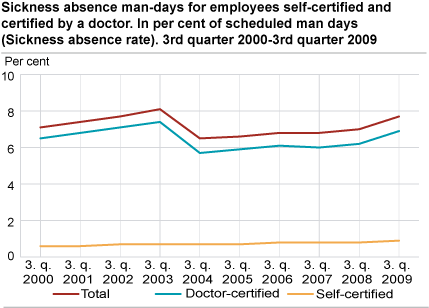Content
Published:
This is an archived release.
Strong increase in sickness absence
The sickness absence rose from 7.0 to 7.7 per cent from the third quarter of 2008 to the third quarter of 2009, an increase of 11 per cent. The growth came in both self-certified and doctor-certified sickness absence.
New industry classificationA new industry classification was introduced from the publication of the first quarter of 2009. The figures for the third quarter of 2008 and the third quarter of 2009 are produced according to the new industry classification. Compared with figures published for 2008 and previous years, there will be a break in the time series for the figures. Here is an article presenting general information about the new Norwegian industry classification . |
The sickness absence for men rose from 5.7 to 6.4 per cent, and for women from 8.6 to 9.4 per cent, a growth of 12.6 and 9.4 per cent respectively.
The sickness absence in the third quarter of 2009 was 3.6 per cent higher than in the third quarter of 2001; the year of implementation of the agreement on an inclusive labour market.
Increase in most industries
All industries faced rising sickness absence in this period, except financial and insurance activities which had a small decrease.
Amongst the major industries, the increase in sickness absence was greatest in real estate activities and professional, scientific and technical activities with 21 per cent, and in construction with 18 per cent.
The sickness absence in manufacturing and public administration increased by 5.6 and 7.3 per cent respectively. However, this is below the average growth of 11 per cent in all industries.
Rise in all sectors
The sickness absence increased by 11.7 per cent in the private sector from the third quarter of 2008 to the third quarter of 2009. In central government (including health enterprises) and local government the growth was 9.3 per cent.
The sickness absence level was lowest in central government and the private sector, with 7.4 per cent, and highest in local government, with 9.0 per cent.
Increased sickness absence in all age groups
Men in the age groups over 25 years had the greatest increase in the doctor-certified sickness absence. For women, the strongest rise was in the age groups 20- 49 years.
These results are based on data on sickness absence certified by a doctor, as the survey on self-certified absence does not contain data on sickness absence by age.
Technical informationRates of change The sickness absence rates are presented using one decimal point. More decimals points are used when calculating the rates of change in order to get more accurate figures. These will therefore differ somewhat from the rates of change produced when using the published rounded figures. The statistics do not cover self-employed persons. |
Tables:
- Table 1 Sickness absence man-days for employees self-certified and certified by a doctor. In per cent of scheduled man-days (Sickness absence rate). Quarterly figures. 2000-2009
- Table 2 Sickness absence man-days for employees self-certified and certified by a doctor, by sex. In per cent of scheduled man-days (Sickness absence rate). Quarterly figures. 2000-2009
- Table 3 Sickness absence man-days for employees self-certified and certified by a doctor, by industry and type of sickness absence. In per cent of scheduled man days (Sickness absence rate). Quarterly figures. 2008-2009
- Table 28 Sickness absence by type of absence (self-certified or doctor-certified) and duration within the quarter
- Table 33 Change in per cent of the sickness absence rate for employees self-certified and certified by a doctor, by industry and type of sickness absence. 2008-2009 Quarterly changes
Tables
Contact
-
Arbeidsmarked og lønn
E-mail: arbeidsmarked@ssb.no
-
Unn H. Høydahl
E-mail: unnh.hoydahl@ssb.no
tel.: (+47) 40 90 23 77

